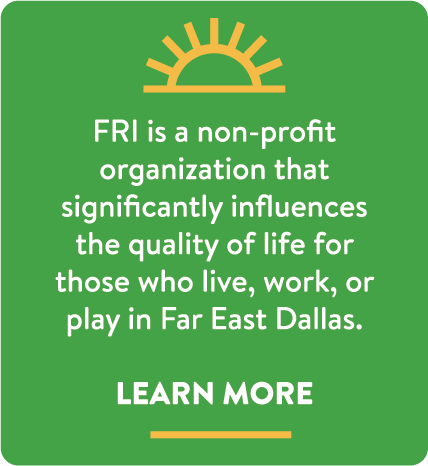City and County Leadership Work Together to Achieve CreekSide
The city of Dallas is stepping up its plan to become a more walkable city with the recent addition of CreekSide, a 4.49-acre urban reserve in Far East Dallas, which will connect to the city’s vast network of over 160 miles of hike and bike trails.
This stretch of natural blackland prairie runs parallel to the lower Ferguson Road corridor between Samuell Boulevard and Lakeland Drive. Nearby neighborhoods — an ethnically and economically diverse community of more than 35,000 residents — will be within a 10-minute walk to CreekSide, affording 17 neighborhoods, 15 multifamily communities and 4 schools easy access to St. Francis and White Rock Hills Parks. Once the Trinity Forest Spine Trail is completed, CreekSide will connect to it, and this will connect to the Santa Fe Trail and White Rock Lake, DART Lawnview Station, the Great Trinity Forest and the Trinity Audubon Center.
“CreekSide is transforming a recreation desert into a recreation destination,” says Vikki Martin, executive director, Ferguson Road Initiative. “This grassroots effort has engaged people to advocate for their own needs and solve their own problems.”
CreekSide is expected to be a catalyst for economic development.
District 1 Dallas County Commissioner Dr. Theresa Daniel, District 9 Dallas City Councilmember Paula Blackmon, and District 7 Dallas Councilmember Adam Bazaldua are strong proponents of CreekSide. They collaborated closely during 2020 to help turn this vision into a reality. FRIdays recently met with them to discuss CreekSide and its impact to our community.
Here is the full transcript of that conversation:
FRIdays: What will the development of CreekSide mean to the residents of Far East Dallas?
District 9 Dallas Councilmember Paula Blackmon: I think it will impact the community far more than imagined. We need to bring together opportunities along all of this corridor. People don’t realize where the boundary lines are politically. All we want is to make sure that it’s seamless and it’s working together. What we have here is an opportunity with another councilmember and our County Commissioner to give the residents what they deserve. That means recreational opportunities that have connections to schools and downtown or parks. We shouldn’t say that, well, this pot of money is only for this district, and that pot of money is only for that district.
We really need all of departments working together to solve complex problems. People don’t care how we get there. They just want a solution and the politics doesn’t need to get in the way. I think that this is an opportunity for a transformation of a community.
District 1 Dallas County Commissioner Dr. Theresa Daniel: I’d like to expand on that. One of the beauties of county government is that we cross jurisdictions. In this situation where a plan is broad enough that it does cross different city council districts, we’re able to bring people together. I am particularly excited about this project, because the Trinity Forest Spine Trail goes from the Trinity Audubon Center up to the Dallas Arboretum. It will be the entry way of all kinds of development, because this part of Dallas County has been fairly neglected when it comes to this.
People say, “Well, why are you wasting money on trails? I don’t even use them.” I say to them, “Yeah, but if they were in your neighborhood, then you at least could make up your mind what you want to do.” I see the Trinity Forest Spine Trail and the complete Loop Trail opening up a lot of potential for the entire county and especially the eastern part. That’s why I’m so excited that these two Councilmembers have the vision to bring something like CreekSide to this part of the County. It will add to and augment the work that FRI has been committed to for more than 20 years, to begin to link up the beads to make a full necklace of trails and expanded transportation options throughout Dallas County.
FRIdays: Councilmember Bazaldua, you’ve been focused on [the redevelopment of] the shopping center at Ferguson and Highland Roads. How does that effort fit into the CreekSide plan?
District 7 Dallas Councilmember Adam Bazaldua: I think the revitalization and redevelopment of the shopping center at Highland and Ferguson Roads speaks to what both Commissioner Daniel and Councilwoman Blackmon were just speaking about regarding blurring district lines. There’s a need for assets that can be used by all citizens across [city council] district lines. When we eliminated that barrier as we envisioned CreekSide, it really opened up to being a blank canvas. We could see how we could maximize this asset for both of our districts. I’m fortunate enough to work with a colleague on the council [Councilmember Blackmon] who when looking at this particular project didn’t have the stance of, “Well, no, that new recreation center is only going to be in District 9.” It was instead, “this actually could be a really great development project to change this entire corner, which could be used as a catalyst for developing the entire [Ferguson Road] corridor.” Councilmember Blackmon has understood the positive impact to both communities as Creekside straddles the District 7/9 boundary.
As mentioned by Commissioner Daniel, I think our County partners are making sure that we have trails also connecting to mass transit. This is a big part of CreekSide. You know, there are a lot of people in my constituency who would probably be frequenters at White Rock Lake if they were able to access a trail safely without having to first figure out how to strap their bikes on a car. These amenities have the potential to develop a multi-modal, multi-income sense of community and overall better quality of life for everybody.
FRIdays:You’ve described this new level of cooperation between the governmental entities. What has changed and why is this happening now, where we can think more holistically and work together?
Commissioner Daniel: There are now people who have been elected who have a mindset towards the greater community. It’s not only us here in this room, but it is our State Representatives and State Senators as well. It’s just amazing what happens when you get like-minded people willing to work together.
Councilmember Blackmon: People don’t want squabbles between their elected officials. At the end of the day, they just want things fixed and they want a better community. So it’s up to us to figure out those ways to work together. The thing is, we want communities that are connected, that feel they’re part of a greater good, a greater whole of the city and county.
FRIdays: How is FRI different from other neighborhood advocacy groups that you’ve worked with in the past?
Councilmember Bazaldua: I always say y’all are the poster child of a grassroots organization, but it’s really hard to call you grassroots anymore because you’re extremely organized. There’s a level of accountability that you expect that keeps me on my toes and it’s very much appreciated. It’s also that you are doing the work. Anytime my office is approached by FRI, it’s always about the work that FRI is already doing, and how my office can help. I believe my job is to help the community leaders who are already doing the work. I don’t think people elected me to come in and rubber-stamp what I thought should happen to their communities.
Councilmember Blackmon: What I love is that everything is always prepared. There’s always a North star. We know exactly where we’re going. It knows the intricate parts of its community. A partnership like this actually makes our job easier because you’ve already vetted [a project before you bring it to us for consideration.] FRI already knows what is needed where, and you’re already moving. Like Councilmember Bazaldua just said, our job is to block and tackle. It is just to open the lane so it gets done faster. And FRI has been very instrumental in the whole revitalization of this area. And I just would love for it to go faster on our end.
Commissioner Daniel: The experience shows. The number of people who are dedicated to the vision of what the community can be like is extraordinary. You know what you’re getting into when you go to meetings with FRI, because it has been hashed out, they have looked at all the options.
Councilmember Bazaldua: You need to bring your “A” game to meetings with FRI, because they’re bringing theirs!
Commissioner Daniel: The involvement of the community is always right there. And it’s a broad swatch of the community, not just a few who happened to show up to meetings. You get a stronger picture and that makes our job easier because then I can go pitch it to my public works department and say this fits in because of the maps and drawings and thought that has been put into it.
FRIdays: Dr. Daniel, can you tell us about your commitment to getting the Ash Creek Trail funded?
Commissioner Daniel: I and the two councilmembers here know very well what it takes to get something through budget. You’ve got to figure out what’s going to make this project sell over another project. And by just being very committed and never giving up, never accepting the answers, but providing the ammunition, the documentation that is needed to support projects like the Ash Creek Trail, that’s what gets it approved over other projects. The Ash Creek Trail represents continuity.
Councilmember Blackmon: We’re seeing with the pandemic that more people want the trails. In Far East Dallas, we don’t have bike lanes and trails. The Ash Creek Trail is a first step to changing that. We’re going to start looking at our bike plan too, because the whole objective is to connect our communities.
Commissioner Daniel: We’ve done a lot of work on intersections so that we can make that connectivity work. It’s also changes in attitudes of elected officials. Ten years ago, it was a lot more difficult to do those kinds of projects because you didn’t have the votes. We are branching out, and thinking about how the community can benefit from all kinds of transportation options. It’s exciting! Part of it too is just providing this area what other parts of the county already have. All of our residents should be able to make the same decisions as anybody else, regarding trails and transportation.
FRIdays: Do you have any closing ideas or something you want to say that we haven’t already talked about?
Commissioner Daniel: Far East Dallas is an untouched gem because when you look at this area, I- 30 is going to be reconfigured. You’ve got access to White Rock Lake and access to the new Trinity Forest Spine Trail. We’re working in my office on how to transform Ferguson Road into a transportation corridor that connects rather than separates. FRI has been part of that discussion. The question is how does that look? What does the community want? How do we use Ferguson Road to connect them to trails, to parks, to schools, to one another? I think this transformation of Ferguson Road is going to happen in the next five to ten years. It’s not a matter of “if”, it’s a matter of “when,” because when people start coming into the area, and they discover there’s hills, there’s trees, there’s lakes and streams, they are going to ask themselves, “Why am I not living here too?”
Councilmember Bazaldua: I just want to say that I’m proud of the work that we, including FRI, have accomplished together. In the short time that I’ve been in office and with the amount of things that we have working, I’m excited to see what we’ll accomplish in the future.







